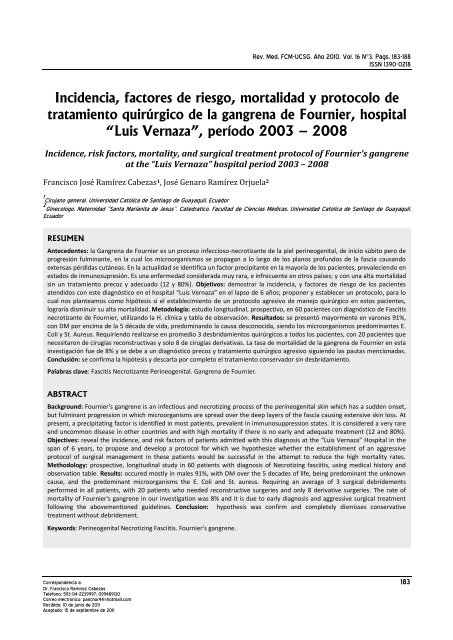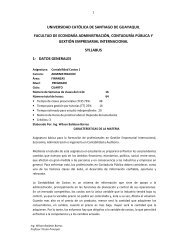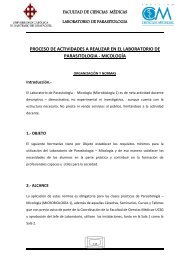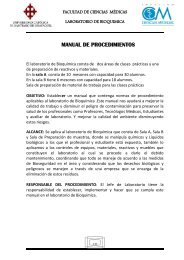el simbolismo médico: la lucha eterna - 201 - Universidad Católica ...
el simbolismo médico: la lucha eterna - 201 - Universidad Católica ...
el simbolismo médico: la lucha eterna - 201 - Universidad Católica ...
You also want an ePaper? Increase the reach of your titles
YUMPU automatically turns print PDFs into web optimized ePapers that Google loves.
Rev. Med. FCM-UCSG. Año <strong>201</strong>0. Vol. 16 N°3. Págs. 183-188<br />
ISSN 1390-0218<br />
Incidencia, factores de riesgo, mortalidad y protocolo de<br />
tratamiento quirúrgico de <strong>la</strong> gangrena de Fournier, hospital<br />
“Luis Vernaza”, período 2003 – 2008<br />
Incidence, risk factors, mortality, and surgical treatment protocol of Fournier's gangrene<br />
at the “Luis Vernaza” hospital period 2003 – 2008<br />
Francisco José Ramírez Cabezas 1, José Genaro Ramírez Orju<strong>el</strong>a 2<br />
1 Cirujano general, <strong>Universidad</strong> <strong>Católica</strong> de Santiago de Guayaquil, Ecuador<br />
2 Ginecólogo, Maternidad “Santa Marianita de Jesús”. Catedrático, Facultad de Ciencias Médicas, <strong>Universidad</strong> <strong>Católica</strong> de Santiago de Guayaquil,<br />
Ecuador<br />
RESUMEN<br />
Antecedentes: <strong>la</strong> Gangrena de Fournier es un proceso infeccioso-necrotizante de <strong>la</strong> pi<strong>el</strong> perineogenital, de inicio súbito pero de<br />
progresión fulminante, en <strong>la</strong> cual los microorganismos se propagan a lo <strong>la</strong>rgo de los p<strong>la</strong>nos profundos de <strong>la</strong> fascia causando<br />
extensas pérdidas cutáneas. En <strong>la</strong> actualidad se identifica un factor precipitante en <strong>la</strong> mayoría de los pacientes, prevaleciendo en<br />
estados de inmunosupresión. Es una enfermedad considerada muy rara, e infrecuente en otros países; y con una alta mortalidad<br />
sin un tratamiento precoz y adecuado (12 y 80%). Objetivos: demostrar <strong>la</strong> incidencia, y factores de riesgo de los pacientes<br />
atendidos con este diagnóstico en <strong>el</strong> hospital “Luis Vernaza” en <strong>el</strong> <strong>la</strong>pso de 6 años; proponer y establecer un protocolo, para lo<br />
cual nos p<strong>la</strong>nteamos como hipótesis si <strong>el</strong> establecimiento de un protocolo agresivo de manejo quirúrgico en estos pacientes,<br />
lograría disminuir su alta mortalidad. Metodología: estudio longitudinal, prospectivo, en 60 pacientes con diagnóstico de Fascitis<br />
necrotizante de Fournier, utilizando <strong>la</strong> H. clínica y tab<strong>la</strong> de observación. Resultados: se presentó mayormente en varones 91%,<br />
con DM por encima de <strong>la</strong> 5 década de vida, predominando <strong>la</strong> causa desconocida, siendo los microorganismos predominantes E.<br />
Coli y St. Aureus. Requiriendo realizarse en promedio 3 desbridamientos quirúrgicos a todos los pacientes, con 20 pacientes que<br />
necesitaron de cirugías reconstructivas y solo 8 de cirugías derivativas. La tasa de mortalidad de <strong>la</strong> gangrena de Fournier en esta<br />
investigación fue de 8% y se debe a un diagnóstico precoz y tratamiento quirúrgico agresivo siguiendo <strong>la</strong>s pautas mencionadas.<br />
Conclusión: se confirma <strong>la</strong> hipótesis y descarta por completo <strong>el</strong> tratamiento conservador sin desbridamiento.<br />
Pa<strong>la</strong>bras c<strong>la</strong>ve: Fascitis Necrotizante Perineogenital. Gangrena de Fournier.<br />
ABSTRACT<br />
Background: Fournier's gangrene is an infectious and necrotizing process of the perineogenital skin which has a sudden onset,<br />
but fulminant progression in which microorganisms are spread over the deep <strong>la</strong>yers of the fascia causing extensive skin loss. At<br />
present, a precipitating factor is identified in most patients, prevalent in immunosuppression states. It is considered a very rare<br />
and uncommon disease in other countries and with high mortality if there is no early and adequate treatment (12 and 80%).<br />
Objectives: reveal the incidence, and risk factors of patients admitted with this diagnosis at the “Luis Vernaza” Hospital in the<br />
span of 6 years, to propose and dev<strong>el</strong>op a protocol for which we hypothesize whether the establishment of an aggressive<br />
protocol of surgical management in these patients would be successful in the attempt to reduce the high mortality rates.<br />
Methodology: prospective, longitudinal study in 60 patients with diagnosis of Necrotizing fasciitis, using medical history and<br />
observation table. Results: occured mostly in males 91%, with DM over the 5 decades of life, being predominant the unknown<br />
cause, and the predominant microorganisms the E. Coli and St. aureus. Requiring an average of 3 surgical debridements<br />
performed in all patients, with 20 patients who needed reconstructive surgeries and only 8 derivative surgeries. The rate of<br />
mortality of Fournier's gangrene in our investigation was 8% and it is due to early diagnosis and aggressive surgical treatment<br />
following the abovementioned guid<strong>el</strong>ines. Conclusion: hypothesis was confirm and complet<strong>el</strong>y dismisses conservative<br />
treatment without debridement.<br />
Keywords: Perineogenital Necrotizing Fasciitis. Fournier's gangrene.<br />
Correspondencia a: 183<br />
Dr. Francisco Ramírez Cabezas<br />
T<strong>el</strong>éfono: 593-04-2239997; 099489130<br />
Correo <strong>el</strong>ectrónico: panchor44@hotmail.com<br />
Recibido: 10 de junio de <strong>201</strong>1<br />
Aceptado: 15 de septiembre de <strong>201</strong>1





